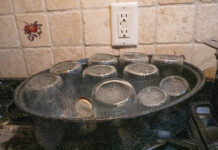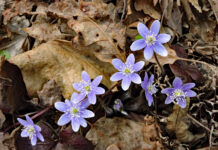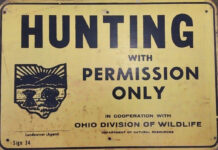As September inches toward October, sportsmen and women are grabbing bows and guns and returning to the fields. Maybe it’s dove hunting that has you sitting on a 5-gallon bucket with a fidgety 10-year-old, or maybe giant Canada geese coaxed you into the cattails with an equally anxious retriever.
I’ll bet that some of you — maybe a lot of you — are trimming limbs and checking tree stands while imagining a big buck is spying while charting its own secret agenda.
While hunting seasons have opened, it isn’t time to put away those fishing rods. As the weather cools, a lot of fish begin feeding hungrily as they instinctively know that leaner months are coming. Perch and walleye are being boated in Lake Erie and eastern lake-fed rivers will have steelhead pushing their way upstream.
You don’t need to drive far to have fun. Inland lakes, farm ponds and streams all offer a lot of fall fishing opportunities. Bass, crappies and bluegill respond well in the fall and catfishing during the evenings can be very productive. Smallmouth fishing in streams mimics many trout techniques, and there’s nothing more relaxing than taking a wading walk while casting into pools.
Neglected

One fish that’s too often neglected is the lowly carp. Although sometimes called an invasive species, it isn’t — it was invited. Transplanted from Asia and Europe, they were stocked across the nation by state and private interests during the early 20th century. Efforts to correct that mistake fell flat due to the carp’s resilience and adaptability. It probably should be considered an “exotic native,” sort of like a brother-in-law who takes up residence in the basement.
Carp can become very active in early fall, feeding on aquatic dwelling larval insects, worms and other edibles it dredges up with its barbel snoot. My father, brother and I had great fun wrestling these muscle laden fish to the net. A few times, especially when fishing along rip-rapped reservoirs, my dad would catch my brother by his belt as a big fish began winning the tug-of-war.
Dad usually tossed the fish back but, being a product of the Great Depression, would still bring an occasional carp home. He claimed that when preparing carp, there were three important elements: 1. how they were cleaned, 2. the cook’s experience and 3. the last decent meal you can remember.
No easy task
If you think catching them is as easy as tossing in a hook, you’re mistaken. Despite their size, somewhere in their little fish brain, they know that they’re still part of the minnow family. Sure, they’re the largest of the family, but they must still have that “survival by flight” entrenched in their genes, gills or wherever they store important information. This means that carp can be more easily spooked than a cat sneaking through a dog show.
For all that timidness, if carp played baseball, they’d still be the sluggers. There’s no bunting or bumping bait for them, when they find something that they like, they swing away and run. That grab and dash technique better have you ready. More than once, unwatched rods have fallen victims when a scaled, muscle-bound behemoth pulled its grab-and-go lunch performance. Keeping the reel’s bail open might help prevent losing a good rig but close attention will ensure it.
Bait
Carp will feed aggressively till the water cools, beginning about the end of September. When that happens, use larger baits to make them believe that their efforts are worthwhile. By this time, they don’t want to use much energy to feed, saving it for surviving the leaner months ahead.
What about baits? Every carp angler has their secret formulas. Bottom rigs using commercial dough ball, cornmeal or boilies work. Boilies are a hardened ball of eggs, protein powder and your choice of baking flavors. Canned corn is also a favorite. Carp can be caught on the surface using baits that float such as dog food, floating bread pieces or goldfish crackers.
I once checked a guy that used garbanzo beans soaked in some secret elixir — or was it the fisherman soaked in some secret liquor? Anyway, he laced corn and those beans on his hook and caught fish. You can also use a fly rod using aquatic worm and insect imitations. I know a couple guys who do well in the Blanchard River. It’s not as flashy as Alaskan salmon but still a lot of fun.
While I hate giving away secrets, my dad had some favorite doughball recipes that I’ll share.
Recipes
Strawberry Killer: Put 1 cup water, 2 tablespoons sugar, 1 teaspoon vanilla extract and 1 or 2 teaspoons garlic salt in a saucepan. Bring ingredients to a boil and then add 1 cup cornmeal, ½ cup flour and ½ package strawberry Jell-O. Cook until mixture thickens. Pour onto waxed paper, flatten and cut into squares. When cool enough to handle, roll into balls.
Corn Dough: Start with 1 can whole kernel corn, 2 cups corn meal, 2 cups flour, ¼ cup sugar, 2 tablespoons vanilla extract and 2 tablespoons sweet corn syrup. Empty corn and juice into large mixing bowl and add corn meal and mix thoroughly. Add sugar, vanilla and sweet corn syrup and mix again. Add flour and knead by hand. Adjust flour as needed.
Old-Timer’s Carp Dough: Take 1 cup of water, 2 tablespoons maple syrup or anise, 1 cup cornmeal, ½ cup rolled oats, ½ cup flour. Heat ingredients, except flour, in a pot over a medium heat while stirring constantly. Add flour until it becomes difficult to stir. A whole grain dry cereal can also be added to thicken.
Sardines and the packing oil, night-crawlers or limburger cheese can be added to create a catfish version. If you decide on one of the catfish varieties, consider an outside cooker or you’ll learn why so few old-timers are left.
Substitutes: Popular ingredients that can be substituted in recipes include Chex, Corn Flakes, Wheaties, biscuit mix, brown sugar, tuna, miniature marshmallows, bacon grease, fruit-flavored sodas and Jell-O mixes.
All should be refrigerated, and most can be frozen and thawed for use.
“Smoked carp tastes just as good as smoked salmon when you ain’t got no smoked salmon.”
— Patrick F. McManus













